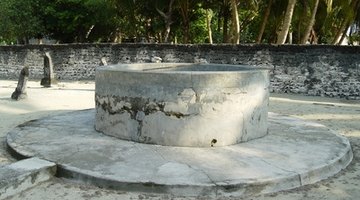Materials Used to Build a Water Well
There are two primary ways to construct a water well: drilling and digging. A drilled well usually goes far down into the ground and taps into an underground aquifer, while a dug well may be only 20 or 30 feet deep. These require different supplies and materials. As long as your water supply is clean and reliable, a dug well can be sufficient, and is less expensive to construct.
Equipment for a Dug Well

A dug well can be dug by hand, and this is the traditional way that many older wells were made. Wells 100 years old are still in use in many parts of the U.S. that were dug by hand and lined with stones. Today, most people use a backhoe to dig a well. Because a backhoe can't reach down 20 feet into a well-sized hole, this is usually done in steps. The backhoe digs a hole deep enough to fit itself into, then goes down to that level and digs another hole even deeper. After water is reached, the larger hole is filled in.
Materials for a Dug Well
While older wells were lined with fieldstone, today most wells are lined with concrete well tiles. A well tile is a cylinder made of concrete that is about 2 feet tall and 2 1/2 feet in diameter. These tiles are stacked on top of one another in the well hole to create a cylinder, and the earth is then backfilled around them. The top piece of the cylinder protrudes from the ground to prevent standing groundwater from entering the well. A cement cap is then fitted on top of the cylinder to keep rainwater, animals, and dirt from getting into the well.
Equipment for a Drilled Well
A large truck-mounted drilling machine that can bore a hole deep into the ground drills the well. Unlike a dug well, a drilled well is only about 8 inches in diameter. The drilling rig has separate sections of drill attached to one another as the hole gets deeper. Drilled wells can be up to 200 feet deep.
Materials for a Drilled Well
A steel casing fitted into the hole protects a drilled well from collapse. Like the drill itself, the casing is manufactured in sections connected together as they go into the hole. The top casing protrudes about 4 feet out of the ground, and is fitted with a steel cap to protect the well from contamination.
References
Writer Bio
Jagg Xaxx has been writing since 1983. His primary areas of writing include surrealism, Buddhist iconography and environmental issues. Xaxx worked as a cabinetmaker for 12 years, as well as building and renovating several houses. Xaxx holds a Doctor of Philosophy in art history from the University of Manchester in the U.K.
Photo Credits
- well image by Amjad Shihab from Fotolia.com
More Articles



